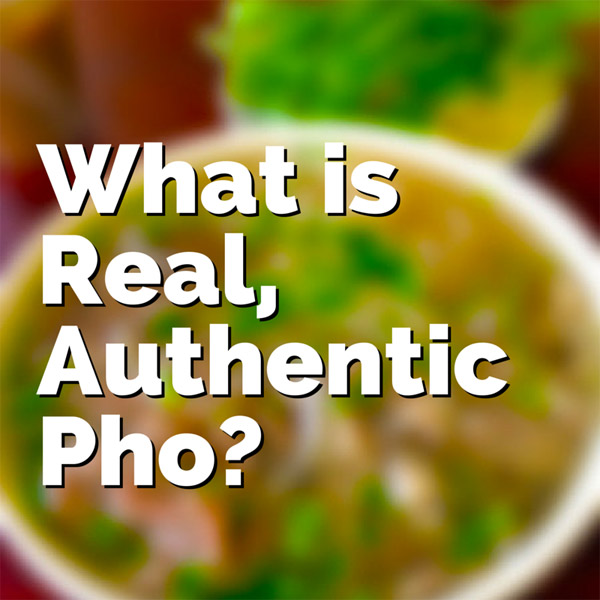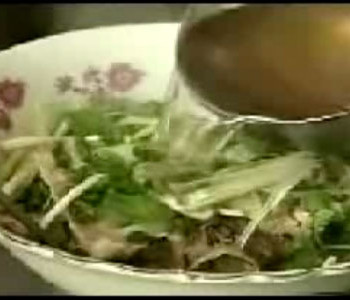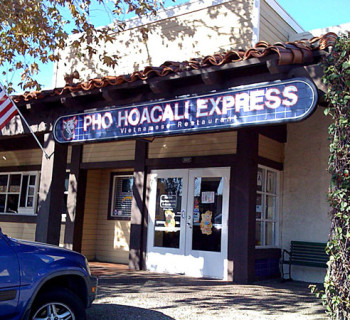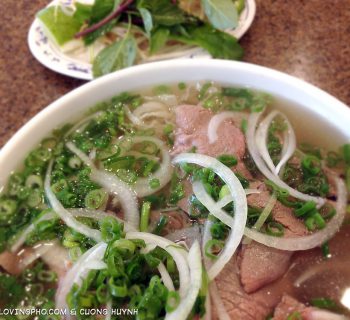 As I advice others on how to open and operate their own pho restaurants, a common pho question always come up searching for a good answer. Seeing that it can result in much confusion or misunderstanding, I want to put this out to share my views on this.
As I advice others on how to open and operate their own pho restaurants, a common pho question always come up searching for a good answer. Seeing that it can result in much confusion or misunderstanding, I want to put this out to share my views on this.
The question I get very often is: what is real, authentic pho and how do I make it?
First a bit of background. I'm not going to go into the whole history of pho here. For that, you can read about The History and Evolution of Pho. For the purpose of this post, the important event was 1975, the end of the Vietnam war, when large number of refugees left the country to settle mostly in the U.S., Canada, Australia and a few European destinations.
At the time, pho was already regional in Vietnam. There was a Northern pho version and there was a Southern pho version which are essentially Hanoi/Nam Dinh pho style and Saigon pho style, respectively. Of course the 2 styles exist today and thriving. They have the same or similar basic ingredients with some variations in ingredients and cooking method/process depending on the region.
The Pho Confusion
Well, 1975 happened, and almost 30 years later, beginning around 2005, pho gained popularity and became pretty much a global phenomenon. It can be found in all corners of the globe. Many people, especially non-Vietnamese, have an opportunity to taste a wide variety of pho during their travel to different places, and more importantly, a lot more freely in Hanoi and North Vietnam. As a result, pho Hanoi is becoming more known and unavoidably is thrown into the mix and discussion of what is real or authentic pho.
I should point out that, pho should not vary widely from place to to place. Good pho should follow a fairly narrow band that defines pho as pho. Anything outside of that band, we already have a name for it, as exemplified by the excellent tasting and awesome hủ tiếu, which does allow for wide regional variations.
So, a few people from mainland China and elsewhere asked me that they want to make authentic pho like being served in California, not in Hanoi or Saigon. A few others mentioned that they like to serve the more "authentic" version with jalapeño as used in North America as opposed to the Thai chili pepper they have in their country.
Wow, what a mess of confusion, wouldn't you say?
I always take the time to explain the difference and what is what and where is why. The risk of being a culinary dish becoming well-known globally in such a short explosive time is to create a mess of confusion. Today people can get pho almost anywhere and some reality is lost not just in the thick of it, but also from a few liberal local pho restaurateurs claiming they serve authentic pho. For those who live near a Vietnamese community in the U.S., Canada, Australia or Europe, or were introduced to pho in these places, it is the Vietnamese pho they know as the real pho, and everything else is compared to it.
The answer of what is real, authentic pho is even more elusive.
Is Global Pho Vietnamese Food Anymore? Well... Yes and No
As in many things in life, we develop personal preferences, habits, or even biases, for a particular food we grow up with. Pho is no exception, even for young Americans these days.
Due to events in 1975, a period of more than 39 years as of 2014, we now have pho outside of Vietnam that has really morphed into something based more on available regional ingredients and taste. For example, the pho you find in North America today originated from almost 100% of the Saigon style brought over to the states from 1975 and after. Over 40 years, it continues to change to fit customer demands and new ingredients; witness the reduced fat and no-MSG use in the broth, the addition of seafood pho, the expansion of vegan pho, and use of wagyu and even Kobe beef. For many pho lovers, there's a real difference in pho in San Jose CA compared to pho served in Little Saigon down in SoCal, and there are fans who will pledge allegiance to either.
During this same 40-year time period, pho within Vietnam continues on its own development path with new younger generation of pho operators, with changing local tastes, and with foreign visitors. Plus there are expatriates coming back to open pho businesses, taking with them Western influences in ingredients and cooking methods. Add to all of this the Northern style and Saigon style pho that are intrinsic to each region in Vietnam, and you can see we have pho going in many directions.
Food and tastes change over time. Pho is no exception.
The Question Remains: What's Real and Authentic Pho?
 There is no definitive answer to the question, and I think I'll leave the academic aspect of this debate to the pho scholars, if they exist at all. For me, I have the following thoughts:
There is no definitive answer to the question, and I think I'll leave the academic aspect of this debate to the pho scholars, if they exist at all. For me, I have the following thoughts:
- If you really want to be correct about it, there is no real, authentic pho except for what’s officially defined by a respected and authoritative body as the real, authentic version in both historical and traditional senses. Unfortunately, this body doesn’t exist at least for the foreseeable future.
- Alternatively, maybe we can define real pho as pho made by a Vietnamese person, or pho made in Vietnam, or pho made by a Vietnamese in Vietnam. Sounds somewhat reasonable, but for me this may be true back around 1975 or even the early 1980's and is no longer true now.
- In the end, I want to enjoy good pho, the kind that I know "tastes right in all aspects" and gives me the "experience that I expect." This, I define as pho that
- Possesses all things that convey the Vietnamese-ness of the dish, including all the basic characteristics in ingredients, preparation, and service of what is known traditionally as pho, with clear tasty broth produced with care using the proper spices, VERY fresh ingredients and herbs, properly served rice noodle, and correct combination of garnishes, AND
- Is instantly recognizable as pho in both look and taste by the majority of people who normally consume pho, AND
- Is enjoyed by a large number of people who are willing to pay for it within the same local area.
This is my strict definition of what real, authentic pho is. It takes into account important elements that, when combined together, contribute to the awesomeness of real, authentic pho. It also takes into account consideration of changing market and environment and time and place.
If you don’t have all 3 of these characteristics, then I would say you don't have real, authentic pho. If you have an empty pho restaurant, then you don't serve real, authentic pho. And it's really meaningless to claim that you serve real, authentic pho from family recipe without all 3 characteristics above. A restaurant may serve good pho, but without all three, it's not real, authentic pho. It's just good pho.
So what do you think? What's your view of real, authentic pho? Please share your opinion in the comments below.




Pho comes from Nam dinh, That is authentic pho. Southern style pho is just imitation of northern style but with use of more sugar and other ingredients to fit their taste since they do not have traditional recipe. However not many foreigners know but authentic Pho is considered as “Pho Nam Dinh” and it is widely popular in Vietnam but really hard to find a restaurant with old traditional recipe. Although Pho is going to different direction but real authentic Pho is only Pho Nam Dinh. However i have not seen traditional pho in North America.
The term Pho means the specific rice noodle used for this bowl of soup. If you change to different kind of noodle, vietnamese people do not call it Pho anymore. But if you change the broth to pork or chicken, it can still be called Pho. Many restaurants in North America uses different noodle but still called Pho, because people do not know and they are used to it…
@Adam: You’re correct about where pho came from, but is it really “widely” popular in Vietnam? Do you have statistics to show this claim? Or maybe it’s based on a few pho shops that you went to in Hanoi, or maybe even in Saigon? If so then that explains it. An analogy is, if you go to the American South, then of course you’d see fried chicken everywhere. But that doesn’t mean it’s widely popular everywhere to the extent and scope you implied for Northern pho in VN.
My mother left North VN in 1954 to Saigon. I’m pretty sure she never made pho before 1954; because people just didn’t make pho at home. Between 1954 and 1975 (when we left Saigon to the U.S.), I don’t remember she made pho once in Saigon. Once in the U.S., she started to make pho at home for a few years because there were not yet pho restaurants in the U.S. at the time. But by late 1970’s and early 1980’s, many pho restaurants began to open, and she no longer made pho at home except on rare occasions with large gatherings of family and friends. And when she did make pho at home, what do you think she made? Yep, pho as most Southern people know it.
I’m not a fan of spending too much time on the authenticity of pho. Like all Vietnamese, I know what pho should be, so what’s there to discuss? It’s like making an argument about where the real authentic hamburger actually came from, or pinpointing where sushi or pizza really originated. The fact is, like many cultural identities and characteristics of different people, race and country, pho has always evolved over time, so authenticity becomes a moot point. For simplicity’s sake without getting to academic level of discussion, the real test may just be: what does Vietnamese people consider pho and where that person came from.
If you want to talk about banh pho noodle, especially when it comes to pho in North America, then your points may have good intentions but are not quite correct. For better discussion about banh pho noodle, you should check out these 2 articles:
/pho-ingredients-garnishes/banh-pho-noodles/
/pho-ingredients-garnishes/a-discussion-on-fresh-banh-pho-quality/
Your comment about pork is 100% incorrect. To a Vietnamese, North or South or wherever, pho does not have pork; neither in the broth nor the toppings. Of course you can always find someone who will say pho can have pork or fish or crab or duck or quail or whatever else they want to throw in there. But then you’re stepping on the ground of fusion foods and that means anything goes really and it’s not a discussion about pho anymore.
I would say in order to be called pho it should have cinnamon, coriander, fennel, cloves, and or star anise. Anything else without that is hu tieu.
@Arun: Thanks for leaving your opinion. Here’s the reality that many non-Vietnamese (and even some new generation Vietnamese) do not realize and/or understand. It’s not that cut and dry to attempt to define pho in such a narrow definition, and it’s not fair for pho to be put inside such a sharp and narrow boundary.
In order to understand food in general and pho in particular, there is a better perspective to consider. Here’s what I’m talking about.
I can go to In-N-Out Burgers and order a burger. Or I can go to Five Guys and order a burger. Or I can also go to a local high-end joint and enjoy a gourmet burger. Or I can go to a popular bar across the street and enjoy a burger. I think it’s safe to say that no one would debate whether each place serves burger or not, or whether they mean it’s beef burger they serve. Of course there are some exceptions but I think you get my point.
When my family and many others arrived in the U.S. in the late 1970s, we made pho at home that didn’t really have all necessary ingredients. But I can assure you that what we made using only what we could find in the U.S. at that time was 100% pho. This is because we knew what pho was supposed to be and with the limited ingredients that were available, we chose only the right ingredients so we could make pho from them. So it’s a lot more than just following a list of ingredients with a narrow definition. It’s more about how you understand the food itself.
Hu tieu is another story entirely and has completely different flavor profile. The only common ingredients are the banh pho noodle and maybe green onions and cilantro for garnishing. You can’t just change a few spices in pho, or not use them at all (as you seem to imply) and get hu tieu out of it. I don’t think it works that way.